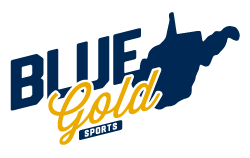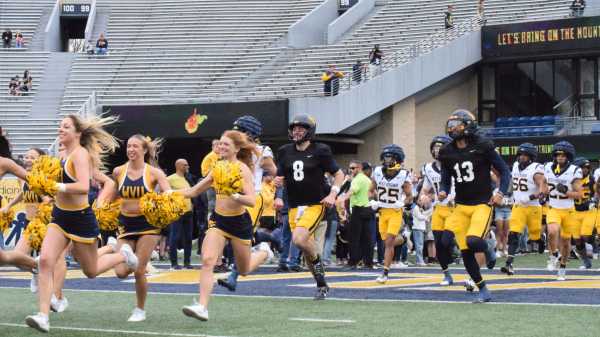Over the Thanksgiving holiday, the West Virginia men’s basketball team participated in the Phil Knight Legacy Tournament in Portland, Oregon.
The tournament garnered national attention, as the games were broadcasted on ESPN and a star-studded field that included Duke, Purdue, Gonzaga, and West Virginia, making it one of the best early season tournaments of the week.
West Virginia went 2-1 in the tournament, with a loss to now No. 5 Purdue and blowout wins against Portland State and Florida.
This early season tournament was good experience for the Mountaineers, as it gave them the opportunity to play three solid team from different conferences, which can help prepare them for NCAA Tournament games.
Here are some takeaways, both good and bad, from West Virginia’s trip out west.
Aaron Parker:
Foul Trouble:
In WVU’s first game against No. 5 Purdue, the Mountaineers were tasked with stopping the formidable, 7-foot-4 center Zach Edey. Edey is without a doubt one of the hardest athletes to guard in college basketball, and with his combination of unmatchable height and strong shoulders, good luck moving him.
Edey had his way with the Mountaineers, shooting 7-for-12 from the field, but the Canada native added 10 more points at the charity stripe.
Edey is one of the best players in the nation, so it’s hard to fault the Mountaineer forwards for allowing 14 points from Edey in the paint, but the fouling of the giant did not help matters. Jimmy Bell fouled out, while Mohamed Wague, Tre Mitchell, and Kedrian Johnson all finished with four fouls.
Game two against Portland State was very choppy at times, especially in the second half. Despite the Mountaineers winning by 18, all five starters recorded at least three fouls, while Bell and Wague each racked up another four fouls at the forward position.
The foul trouble really only came back to haunt West Virginia against Purdue, but it could be an issue that plagues the team down the stretch against well-rounded Big 12 opponents with a deep inside presence.
Turnovers: Turnovers affected West Virginia in both a positive and negative way at points of the three-game stretch in Portland.
Against Portland State, the Mountaineers forced 23 Viking turnovers, but gave the ball away 18 times themselves. The turnovers given up by WVU may be nit-picking, as the Mountaineers limited their turnovers to 13 against both Purdue and Florida, but it’s always important to monitor as the season progresses.
While 18 turnovers may be a little alarming, the Mountaineers have plenty of experience at the point guard position with Kedrian Johnson and Joe Toussaint. Both point guards know how to handle the ball against Power Five opponents, but with a roster full of players that are either young or new to WVU, there are bound to be some miscommunications and lack of execution at the beginning of the season. The turnovers aren’t a problem now, but it should be a point of emphasis for this WVU team to take care of the ball consistently.
Fast Starts: Against Purdue, WVU started the game down 9-0, and trailed by 11 points at halftime. The Mountaineers had to play from behind, and they did a good job of fighting throughout the second half, but the slow start proved to be costly.
In the back two games of the tournament, WVU flipped the script and were the aggressors in both the Portland State and Florida games.
The fast start was hoped for against Portland State, but against a talented SEC team in Florida, the strong first half was encouraging to see.
The Mountaineers were able to get the talented big men of Florida (Colin Castleton and Jason Jitoboh) in heavy foul trouble in the first half, and the Gators could not come back from that.
Coming ready to play out of the gates will be a big factor this year, and it may be the difference in back-and-forth games in conference play. This team has shown their desire to win, and the fast starts show a lot about the level of focus and effort this team has.
Consistent Scoring: A problem in last year’s team was getting consistent offensive production from someone not named Taz Sherman. This year appears to be a breath of fresh air, as a hand full of new faces can score at an impressive rate.
To start, let’s talk about the shooting of Erik Stevenson. The South Carolina transfer is averaging 14.1 points per game and is shooting 55.2% from the field, while also shooting 48.3% from beyond the arc. Stevenson scored 17 points against Purdue, 11 against Portland State, and 15 against Florida while in Oregon.
Stevenson’s smooth stroke and confidence makes him a legitimate threat from anywhere on the court. Picking up the Washington native from the portal seems to be a big win for Bob Huggins. Another win in the transfer portal has been forward Tre Mitchell. Mitchell is a natural scorer that can make shots with his back to the basket but can also step out and shoot jump shots at 6-foot-9.
Mitchell is averaging 12.6 points per game and his performances against Portland State and Florida proved to be vital to WVU’s success. In the early parts of the trip, Mitchell battled a stomach bug, which affected the Texas transfer against Purdue.
After only scoring two points against the Boilermakers, Mitchell came back with 16 points against Portland State and 17 points against Florida. Mitchell’s natural ability to score as a forward was probably evident before the west coast trip, but if it wasn’t before, now it’s a clear takeaway.
Also contributing to the consistent scoring so far has been Iowa transfer Joe Toussaint. Toussaint’s scoring has surprised many WVU fans, as the senior point guard averaged under five points per game last season for the Hawkeyes but is now averaging over 11 points per game to start his WVU career.
Toussaint took over offensively for WVU in the blowout win at Pitt, scoring 18 points off the bench. Toussaint kept scoring while in Oregon, registering 16 points against Purdue, 11 against Portland State, and nine against Florida.
Wesley Shoemaker
Consistent Big Play: The additions of Jimmy Bell and Mohamed Wague have certainly helped this team, but there needs to be a consistency factor there. Both have struggled scoring sometimes and both have gotten into foul trouble.
Yes James Okonkwo is a third option along with Tre Mitchell, but there is a drop off from Bell/Wague to Okonkwo. Over time Okonkwo will develop more, but when you have two main options and both are in constant foul trouble (like against Purdue), then you can run into trouble.
Through West Virginia’s first seven games, Bell has scored, 0, 3, 10, 6, 4, 4, and 5 points, along with 3, 3, 2, 3, 5, 4, and 3 fouls in each game respectively. Bell has not played more than 19 minutes in a game this season. Wague is somewhat similar, scoring, 9, 11, 10, 3, 4, 5, and 8 points in each game, while committing 4, 4, 4, 2, 4, 4, and 2 fouls in each game this season. Wague has also not eclipsed the 20 minute mark.
Shooters Shooting: The way this West Virginia offense played against Florida was fabulous and hopefully that is a sign for things to come.
This season West Virginia is averaging 80.1 points per game, while shooting 49.4% from the field which is third-best in the Big 12. West Virginia has relied heavily upon Erik Stevenson, who has scored at least 10 points in all but one game this season. Stevenson along with Tre Mitchell, Emmitt Matthews, as well as improved point guard play from Kedrian Johnson and Joe Toussaint have set this offense up to continue to progress.
In addition, West Virginia shoots 35.3% from three-point range which is also third-best in the Big 12.
Team Rebounding: The only consistent issue I have seen with this team is their lack of dedication to team rebounding.
This means, West Virginia seems to think not all five guys need to go after the basketball. There are times when other teams have guards get rebounds because West Virginia’s guards are not crashing towards the glass. Yes this team wants to play in transition, but if they can’t rebound they won’t get any transition opportunities.
Photo by Aaron Parker, Blue Gold Sports
Discover more from Blue Gold Sports
Subscribe to get the latest posts sent to your email.




























